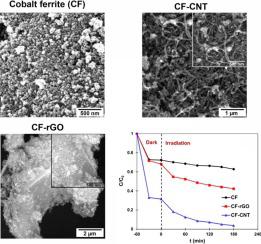Journal of Photochemistry and Photobiology A: Chemistry ( IF 4.1 ) Pub Date : 2020-08-29 , DOI: 10.1016/j.jphotochem.2020.112867 F. Jelokhani , S. Sheibani , A. Ataie

|
In this research, cobalt ferrite (CF)-reduced graphene oxide (rGO) and CF-carbon nanotube (CNT) nanocomposites were successfully prepared through a facile co-precipitation method at a low temperature. The structure, microstructure, magnetic, optical and photocatalytic properties of the as-prepared nanocomposite samples were characterized by X-ray diffraction (XRD), field emission scanning electron microscopy (FESEM), vibrating sample magnetometer (VSM), diffuse reflectance spectroscopy (DRS), Photoluminescence (PL) spectrometer and Fourier transform infrared spectroscopy (FTIR). The mean particle size and saturation magnetization were decreased by the addition of rGO and CNT to the CF. The band gap of the CF decreased from 1.55 to 1.50 and 1.45 eV in presence of rGO and CNT, respectively. The recombination rate of photo-induced electron-hole pairs was further decreased by CNT compared to the rGO. A detailed study on the mechanism and kinetics of dark adsorption and photocatalytic degradation of methylene blue (MB) aqueous solutions by different samples was done. The degradation results were fitted with a high degree of correlation to the Langmuir-Hinshelwood (L-H) model and those for adsorption to the Langmuir model. CF-CNT nanocomposite showed the highest dark adsorption capacity and MB degradation efficiency in all MB concentrations. For the degradation of 10 mg/L methylene blue (MB) solution under visible light, the photocatalytic efficiency of CF-CNT nanocomposite reached 97% within 180 min of reaction time, which was 1.8 times higher than that of CF-rGO nanocomposite and up to 2.5 times than that for pure CF nanoparticles. The remarkable visible light photocatalytic performance CF-CNT nanocomposite with a maximum kinetic rate constant was mainly attributed to the structural, morphological and optical properties. According to the reusability test, only a slight decrease of 4% was observed after the third cycle.
中文翻译:

钴铁氧体还原氧化石墨烯和钴铁氧体-碳纳米管纳米复合材料的吸附和光催化特性
在这项研究中,通过一种简便的低温共沉淀方法成功地制备了钴铁氧体(CF)还原的氧化石墨烯(rGO)和CF-碳纳米管(CNT)纳米复合材料。通过X射线衍射(XRD),场发射扫描电子显微镜(FESEM),振动样品磁力计(VSM),漫反射光谱(DRS)表征了制备的纳米复合材料样品的结构,微观结构,磁性,光学和光催化性能。 ),光致发光(PL)光谱仪和傅里叶变换红外光谱(FTIR)。通过在CF中添加rGO和CNT可以降低平均粒径和饱和磁化强度。在存在rGO和CNT的情况下,CF的带隙分别从1.55降低至1.50和1.45 eV。与rGO相比,CNT进一步降低了光诱导电子-空穴对的重组率。详细研究了不同样品对亚甲基蓝(MB)水溶液的暗吸附和光催化降解机理和动力学。拟合的降解结果与Langmuir-Hinshelwood(LH)模型以及与Langmuir模型的吸附高度相关。CF-CNT纳米复合材料在所有MB浓度下均表现出最高的暗吸附容量和MB降解效率。在可见光下降解10 mg / L亚甲基蓝(MB)溶液,CF-CNT纳米复合材料的光催化效率在180分钟内达到97%,是CF-rGO纳米复合材料的1.8倍甚至更高。是纯CF纳米颗粒的2.5倍。具有最大动力学速率常数的非凡可见光光催化性能CF-CNT纳米复合材料主要归因于其结构,形态和光学性质。根据可重用性测试,在第三次循环后仅观察到4%的轻微下降。











































 京公网安备 11010802027423号
京公网安备 11010802027423号